Wat Arun is a famous Buddhist temple in Bangkok. Commonly known as ‘The Temple of Dawn', it was built in the 17th century and named after the Hindu God Aruna.
The distinctive spires, or pagodas (called ‘prang'), were built in the early 19th century and are encrusted with porcelain and seashells.
The spires stand over 200 feet high. The central prang is topped with a seven-pronged trident, referred to by many sources as the “Trident of Shiva, Shiva being the God of Meditation, Yoga, Time and Dance (1).
The grand pagoda is surrounded by four smaller ones, and each has beautiful characteristics such as guardians facing all four directions.
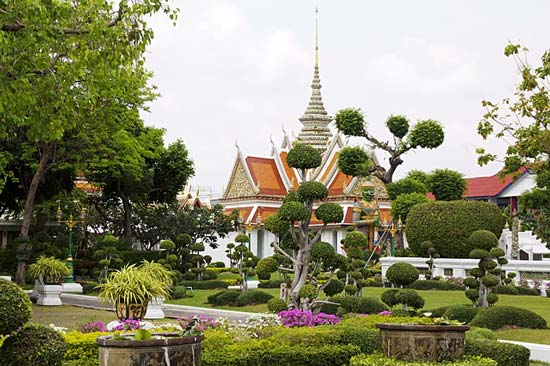
During the Ayutthaya era (1350-1767), ships would sail along the river and stop at the junction near the temple to refill their supplies. Here the sailors would worship and pray in front of the temple.
It is thought that King Taksin would visit the temple at dawn, prompting the name to be changed from Wat Makok (or Wat Makok Nok) to Wat Chaeng, its local name.
The temple had been abandoned until the reign of King Rama II (1809-1824), at which point it was restored and the main pagoda raised to 229 feet (70 m).
Wat Arun underwent renovation on its spires from 2013-2017. Broken tiles were replaced and many surfaces were refinished with plaster to replace the cement from previous restorations.
Now the temple sits majestically on the bank of the Chao Phraya River, glistening in the sun and watched over by passing boats.
It is one of the most iconic temples in Bangkok and appears on the back of the 10 Baht coin.
What to See at Wat Arun
There is plenty to explore at Wat Arun.
Visitors can climb the central spire but should be cautioned that the steps are steep and narrow. It can be challenging going up and coming down but the views are well worth it.
There is also a crown at the top that was put in place by King Rama III.
Bring some binoculars and a camera to see further afield and try to identify landmarks around the city.
Look out for the impressive sculptures of animals and Chinese soldiers around the base of the central spire. For those interested in Buddhism, there are many Buddha murals around the temple which tell the story of his life.
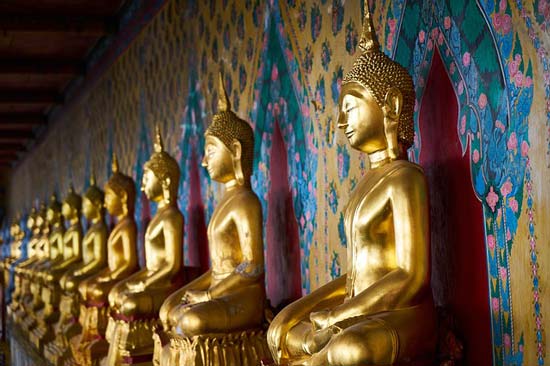
There is also a Buddha statue in the Ordination Hall, supposedly designed by King Rama II and rumored to have some of his ashes kept underneath.
On one of the terraces there are four statues of Indra, the Hindu God, located near a three-headed elephant.
Located on the river facing side of the temple are several pavilions with Chinese style architecture.
Cameras are allowed inside Wat Arun, so you'll be able to take plenty of pictures of your visit.
Outside of the temple, the grounds house several small buildings, shrines, and ponds that complement the temple and are worth walking around.
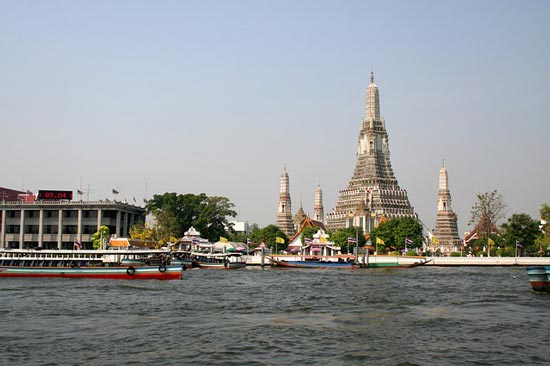
How to Get to Wat Arun
Wat Arun is located on the west (Thonburi) bank of the Chao Phraya River and is easily accessed from several directions via boat, train, bus, or taxi.
There are a number of canal tours that take tourists to the temple, and water taxis can also be taken from Saphan Taksin Station (Silom Line).
Directions from the East
Many people visit the Grand Palace first and then take a boat over to see Wat Arun.
To do so, take a boat from the Tha Tien Pier (No. 8), which is located at the southwest corner of the Grand Palace.
Boats run back and forth between both attractions quite frequently and tourists should look for boats with an orange flag.
These boats run more frequently and are larger and cheaper than the blue flag boats, and often less crowded too.
To reach Tha Tien, take buses 1, 25, 44, 47, 62, or 90, which stop on Maharat road, right behind the pier near the Tha Tien Market.
From the Grand Palace, it is approximately 5 minutes walk to the pier.
Directions from the West
On the West bank of the river, the temple can be accessed by car via Arun Amarin Road.
There are also multiple bus stops one road beyond Arun Amarin on Itsaraphap Rd. It is easy to cross to the East bank over the Phra Pokklao Bridge ,which is about 1.5 miles from Wat Arun, or to take a taxi to Tha Tien Pier.
Directions from the Airport
From the airport, take the Airport Rail Link to the Phayathai and transfer to the Sukhumvit Line.
Get off at Siam station and transfer to the Silom line toward Bang Wa. Get off at the last stop and walk approximately 15 minutes, or take a taxi to Wat Arun.
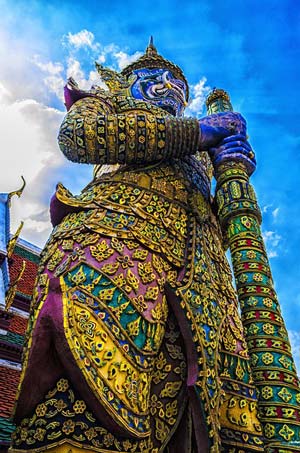
Visiting Hours & Best Times to Visit
The temple is open to public visitors from 8:30 am to 5:30 pm daily.
Go as early as possible to beat the crowds.
Weekdays may also be slightly less crowded than the weekend, although there are always tourists eager to visit the temple.
Although the name of the temple references the dawn, it is also stunning to see at sunset. Even if the temple is closed to visitors, it is still a wonderful view from the East bank of the river to see it lit up by the setting sun.
The porcelain in the spires shines in the sun and makes for a spectacular view and photo opportunity.
Many visitors spend at least an hour exploring the interior of the temple or climbing the central spire for sweeping views of the river and Grand Palace.
Location
The Google map below shows the exact location of Wat Arun. You can show this to your taxi driver if he is confused as to where you want to go.
Wat Arun Pricing
Admission to the temple is costs 30 Baht (approximately $1 USD) for foreigners to enter.
Thai citizens enter free of charge, and can enter daily to use the temple as a place of worship.
Temple Dress Code
Because Wat Arun is an active temple and place of worship for many Buddhists in Bangkok, a dress code should be observed .
Visitors are expected to dress with appropriate modesty and respect.
Men should wear long trousers and shirts with sleeves (either short or long). Women’s trousers or skirts should be at least knee length and tops should not reveal shoulders.
+ Read more on dress code in Thailand
Transparent clothing of any length is not permitted and revealing garments should also be avoided.
All visitors must remove their shoes prior to entering and leave them in the allocated area outside. Some tourists may be asked to put on a scarf or rent as sarong if their clothing is deemed to be inappropriate.
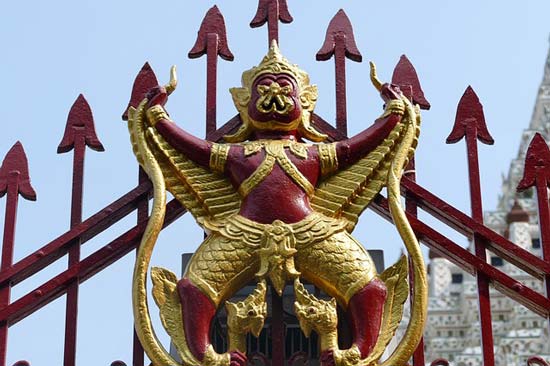
3 Things to See Near Wat Arun
Wat Arun is conveniently located close to several other popular attractions in Bangkok, so make a day of it and try to see more than just Wat Arun.
Here's a few tips for you
1. Grand Palace & Wat Pho
The Grand Palace, a walled complex of several buildings (outer court, middle court, and inner court), is one of the most visited destinations in Thailand. The grounds comprise several buildings, halls, pavilions, lawns, gardens, and courtyards.
+ Read more on the Grand Palace here
Housed within the Grand Palace is Wat Pho, also known as the Temple of the Reclining Buddha. The reclining Buddha itself is 150 feet long and covered in gilded gold. This really is a must see.
The temple also houses one of the largest collections of Buddha images in the world.
In addition to many murals, Wat Pho also features a pleasant courtyard with a Bodhi tree.
Important: Don't forget to ignore any touts that tell you “the Grand Palace is closed. More on that here.
2. Wat Phra Kaew
Wat Phra Kaew, the Temple of the Emerald Buddha, is also nearby and arguably the most sacred Buddhist temple in Thailand.
It is known for its dark green statue of the Buddha, which stands 26” tall and was carved from a single piece of jade.
3. The Museum of Siam
The Museum of Siam is also located just across the river from Wat Arun, and is dedicated to “discovering Thainess.”
You needn't bother though. Just come and stay in my house for a couple of days; you'll get all the Thainess you need :).
Seriously, though, this museum does a pretty good job of showing you what makes Thailand, well, Thailand. It covers history, culture, food and many other influences.
It's actually a welcome reprieve from the crowded temples, and a good way to escape the heat and learn a little bit more about this beautiful country.
In Summary
I've heard people say that “Once you've seen one temple in Thailand you've seen them all”.
I understand this comment because many of the temples in rural Thailand resemble each other, much like churches in the UK. However, these Bangkok attractions are certainly different and worth seeing once in your lifetime.
It really is advisable to start out early and make a day of it. Remember, the Thai midday sun is roasting, so come lunchtime you'll want to sit down and cool off with a drink.
Don't worry about food as there's plenty of cafes and restaurants dotted around. You're never more than 100m away from a snack or drink in Bangkok!
Last Updated on
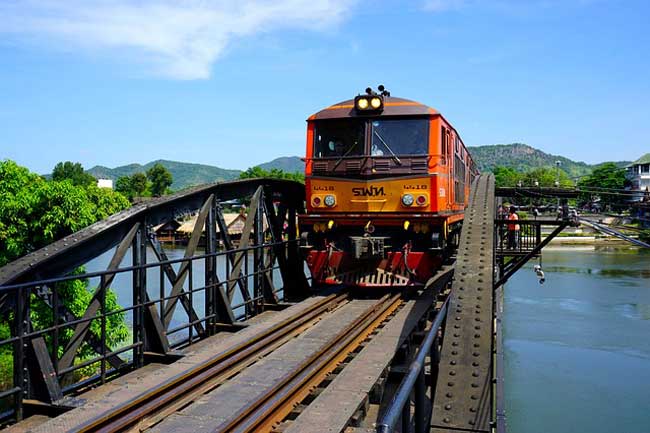
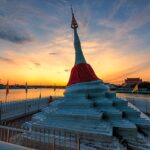
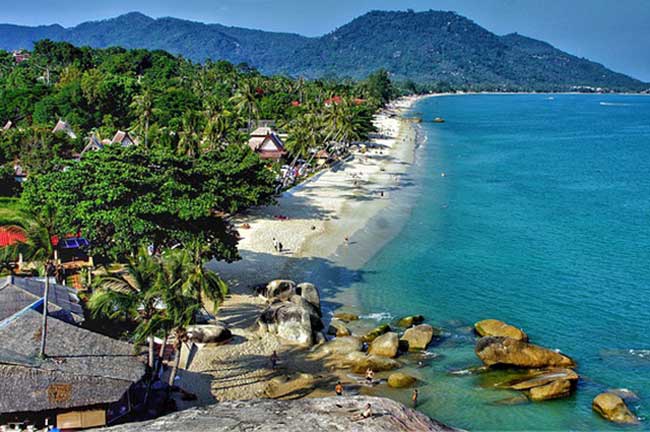
Chan Yew Gin says
May 02, 2019 at 11:17 am
James E says
May 02, 2019 at 9:30 pm
James E says
Mar 10, 2019 at 12:16 am
TheThailandLife says
Mar 10, 2019 at 11:36 pm
James E says
Another reasonably close must-see that is never crowded and very interesting is The Temple of the Golden Mount at Wat Saket. While the wat is very much a working school and not really set up for tourists, the temple is spectacular and is rich in the semi-macabre history that afflicts many Thai temples. Plus the view is spectacular, it's close by the Michelin-starred Jai Fai and Thipsamai street food and it's about a 20 minute walk (or 50 Baht taxi ride) to Tha Tien past the Giant Swing and through some very interesting neighborhoods (full-sized, lifelike monk anybody?).
Wat Arun is at the top of my list for next trip.
Mar 04, 2019 at 9:17 am
TheThailandLife says
Mar 04, 2019 at 7:05 pm